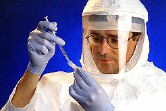
FRIDAY, July 26 (HealthDay News) — Important differences between Middle East respiratory syndrome (MERS) and severe acute respiratory syndrome (SARS) suggest that MERS won’t prove as dangerous as SARS, researchers report.
MERS emerged last year in Saudi Arabia and nearly all cases of infection have been reported there, or in people who were infected with the virus there before traveling to other countries. Between Sept. 1, 2012, and June 15, 2013, there were 47 confirmed cases (46 adults, one child) of MERS infections in Saudi Arabia, according to the report published July 25 in The Lancet Infectious Diseases.
As of July 24, the U.S. Centers for Disease Control and Prevention said there had been 90 MERS cases worldwide.
An analysis of clinical records, laboratory results and other data revealed that older people, men and patients with chronic health problems are more likely to succumb to the disease, the investigators said.
Like those infected with SARS, people with MERS have a wide range of symptoms. Most patients admitted to the hospital had fever (98 percent), chills (87 percent), cough (83 percent), shortness of breath (72 percent) and muscle pain (32 percent). One-fourth of patients also had gastrointestinal symptoms, such as vomiting and diarrhea.
Unlike SARS, however, nearly all of the cases of MERS occurred in people with chronic health conditions, such as diabetes (68 percent), high blood pressure (34 percent), chronic heart disease (28 percent) and chronic kidney disease (49 percent).
“Despite sharing some clinical similarities with SARS (e.g., fever, cough and incubation period), there are also some important differences, such as the rapid progression to respiratory failure, up to five days earlier than SARS,” study leader Ziad Memish, the deputy minister for public health from the Kingdom of Saudi Arabia, said in a journal news release.
“In contrast to SARS — which was much more infectious, especially in health-care settings, and affected the healthier and the younger age group — MERS appears to be more deadly, with 60 percent of patients with co-existing chronic illnesses dying, compared with the 1 percent to 2 percent toll of SARS,” Memish said.
“Although this high mortality rate with MERS is probably spurious due to the fact that we are only picking up severe cases and missing a significant number of milder or asymptomatic cases, so far there is little to indicate that MERS will follow a similar path to SARS,” Memish added.
Study co-author Ali Zumla, from University College London in the United Kingdom, said that “the recent identification of milder or asymptomatic cases of MERS in health-care workers, children and family members of contacts of MERS cases indicates that we are only reporting the tip of the iceberg of severe cases and there is a spectrum of milder clinical disease which requires urgent definition.”
“Ultimately, the key will be to identify the source of MERS infection, predisposing factors for susceptibility to infection and the predictive factors for poor outcome,” Zumla said in the news release. “Meanwhile, infection control measures within hospitals seem to work.”
In an editorial accompanying the report, Christian Drosten, of the University of Bonn Medical Center in Germany, said there is an urgent need to develop accurate diagnostic tests to help focus efforts to control MERS and to minimize the risk of it spreading from infected patients to other people.
More information
The U.S. Centers for Disease Control and Prevention has more about MERS.
Copyright © 2025 HealthDay. All rights reserved.

